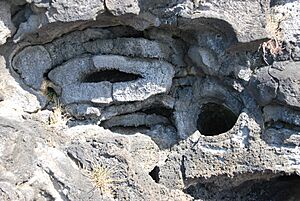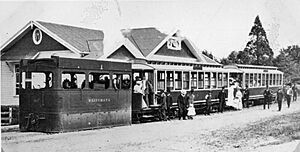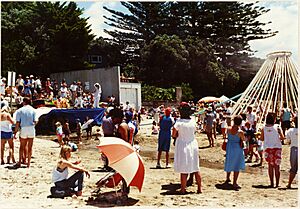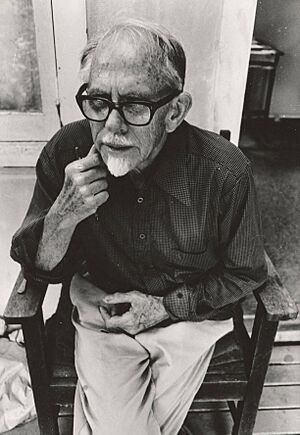Takapuna facts for kids
Quick facts for kids
Takapuna
|
|
|---|---|
|
Suburb
|
|
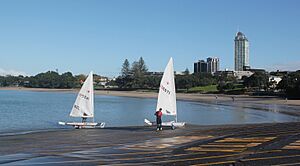
Takapuna Beach with Takapuna visible in the background
|
|
| Country | New Zealand |
| Local authority | Auckland |
| Electoral ward | North Shore ward |
| Local board | Devonport-Takapuna Local Board |
| Established | 1847 |
| Area | |
| • Land | 455 ha (1,124 acre) |
| Population
(June 2023)
|
|
| • Total | 11,860 |
| Postcode(s) |
0622
|
| Busway station(s) | Smales Farm busway station |
| Hospitals(s) | North Shore Hospital |
|
|
||
Takapuna is a lively suburb on the North Shore of Auckland, New Zealand. It sits on a narrow strip of land, like a bridge, between Shoal Bay (part of the Waitematā Harbour) and the Hauraki Gulf. Inside Takapuna, you'll find Lake Pupuke, a freshwater lake formed by a volcano long ago.
Māori people first settled in Takapuna around the 13th or 14th centuries. They used the lake's resources and a special grove of pōhutukawa trees called Te Uru Tapu. This grove was important for funeral ceremonies and still exists today. In 1847, the first European farmers arrived. Takapuna became a popular holiday spot for wealthy families in the 1880s. By the early 1900s, Takapuna Beach was a major tourist attraction. The area grew even more after the Auckland Harbour Bridge opened in 1959, becoming a main center for the North Shore.
Contents
What's in a Name? The Story of Takapuna

The name Takapuna comes from a spring at Maungauika / North Head, which is in Devonport. The name was given by Hoturoa, a leader from the Tainui canoe, a famous Māori migration boat. When the Tainui stopped at Torpedo Bay, Hoturoa and his crew drank from the spring. He named it to remember a spring from his homeland, Hawaiki.
In the Māori language, puna means "natural spring." The meaning of taka in this name is not fully known. It could mean "Knoll Spring," "Rock Spring," "Cliff Spring," or "Falling Spring."
Over time, Tāmaki Māori started using Takapuna to describe the wider area around North Head and the North Shore. An early explorer, Jules Dumont d'Urville, was the first European to use the name for the area north of North Head in 1833. For many years, Lake Pupuke was even called Lake Takapuna.
The area was known as the Lake District from 1866 to 1882. Then, the name Takapuna was officially adopted. It slowly came to mean the settlement around the southern shores of Lake Pupuke.
Takapuna's Land and Nature

The land on the North Shore is mostly made of sandstone from the Waitemata Group. This rock formed on the sea floor millions of years ago. Takapuna is home to Lake Pupuke, a volcanic lake that erupted about 193,200 years ago. It's one of the oldest volcanic features in the Auckland volcanic field.
When Lake Pupuke erupted, lava flowed east through the area. This lava covered the bottom parts of tree trunks, turning them into rock. This created the Takapuna Fossil Forest, which you can see today because of coastal erosion.
Before people settled here, the coast had many pōhutukawa trees. Inland, there were forests of kauri and other native trees. By the 1850s, Takapuna was mostly covered in mānuka bushes, with harakeke (flax) along the coast.
Where is Takapuna?
Takapuna is a narrow piece of land (an isthmus) between the Hauraki Gulf and Shoal Bay. Shoal Bay is a long, narrow part of the Waitematā Harbour. Takapuna is surrounded by other suburbs: Hauraki to the southeast, Northcote to the southwest, Hillcrest and Wairau Valley to the west, and Milford north of Lake Pupuke. The highest point in Takapuna is about 34 meters above sea level.
Takapuna has two beaches on its eastern side. Takapuna Beach faces Rangitoto Island. Further north is Thorne Bay, which has a rock formation called Black Rock. Barrys Point is a piece of land that sticks out into Shoal Bay.
Takapuna's Past
Māori History and Legends
Māori people first settled in the Auckland Region around the 13th or 14th centuries. The Devonport-Takapuna area was one of the first places they lived. The Tainui canoe visited Takapuna around 1350. Some of its crew stayed and married local people. Villages (kāinga) were found throughout Takapuna, protected by fortified villages (pā) at Castor Bay, Takarunga / Mount Victoria, and Maungauika / North Head.
Over time, these people became known as Ngā Oho and Ngāi Tai. Later, a warrior named Maki united many tribes, forming Te Kawerau ā Maki. His daughter, Kahu, is the namesake of the North Shore, Te Whenua Roa o Kahu ("The Greater Lands of Kahu"). Many local tribes today trace their family lines back to Kahu.
In the 17th century, Ngāti Pāoa attacked settlements around the Waitematā Harbour. Later, during the Musket Wars in the early 1820s, most Māori people left the North Shore for safer areas.
Lake Pupuke and the Wrath of Mataaho
Lake Pupuke was very important to the Māori people of the North Shore. It provided fresh water, and its name Pupuke Moana means "Overflowing Sea," because water would flow from the lake to the ocean. People gathered eels and mussels from the lake and snared birds. They also harvested harakeke (flax) for making clothes and mats.
Takapuna is part of a Ngāi Tai ki Tāmaki traditional story called Te Riri a Mataaho ("The Wrath of Mataaho"). This story explains how Lake Pupuke and two rock formations on Takapuna Beach, called Ngā Mahanga ("The Twins"), were created. It tells of two children of the Fire God Mataaho who argued, causing Mataaho to destroy their mountain home and create Lake Pupuke and Rangitoto. The children were turned to stone on Takapuna Beach.
Te Uru Tapu: A Sacred Grove
North of Takapuna Beach is a sacred place (wāhi tapu) called Te Uru Tapu. It's a grove of pōhutukawa trees used by Tāmaki Māori for burial ceremonies. Bodies were placed in the trees, wrapped in flax mats, and later buried after they had naturally decomposed.
In 2021, some trees in the grove were damaged by vandals.
Early European Settlement

The first European farmers arrived in Takapuna in 1847. They were mostly from England, Scotland, and Ireland. They set up farms around Lake Pupuke, growing crops like wheat, corn, and potatoes.
In 1849, the Catholic Church bought land in Takapuna. Jean-Baptiste Pompallier started St Mary's College there, a school for both European and Māori students.
In 1852, the Crown gave land south of Lake Pupuke to Ngāpuhi chief Eruera Maihi Patuone. This was meant to protect Auckland from northern tribes. Patuone named his settlement Waiwharariki. His people lived there until the 1880s.
In 1863, the first housing areas were created in Takapuna, with villas built near Lake Pupuke. A ferry service started from Barry's Point, and the Takapuna Hotel opened. Takapuna continued to grow, and a post office opened in 1880.
During the 1880s, Fort Takapuna was built due to fears of a Russian invasion. Lake Pupuke became the main source of fresh water for the North Shore.
Tourism and Trams
By the late 1880s, Takapuna was a popular place for tourists, especially Lake Pupuke. Wealthy businessmen built summer homes around the lake. Later, many moved there permanently and traveled to Auckland by ferry for work.
By the early 1900s, Takapuna Beach became the main attraction. The Mon Desir Hotel opened on the beachfront in 1909.
In 1910, a private tramway was built in Takapuna. It took passengers to the ferry at Bayswater. This tramway helped Takapuna grow quickly. However, it closed 17 years later in 1927.
By the 1930s, Takapuna changed from a tourist spot to a busy suburb of Auckland. Summer homes were replaced by permanent houses, and Takapuna became a commercial hub for the North Shore.
During World War II, coastal defenses were built around Takapuna. North Shore Hospital opened in 1958, becoming the first major public hospital on the North Shore.
Growth After the Harbour Bridge
The Auckland Harbour Bridge opened in 1959, connecting the North Shore to Auckland City. This led to a huge increase in suburban growth across the North Shore. Takapuna became the main administrative center for Takapuna City (formed in 1961) and later for North Shore City (formed in 1989).
Major shops like Woolworths and Milne & Choyce opened in Takapuna. The Shore City Shopping Centre also opened. In 1962, Takapuna was where the COMPAC submarine communications cable connected Auckland to Fiji and Canada. This system was used until 1984.
The Bruce Mason Centre, an events venue, opened in 1996. In the late 1990s, a commercial complex called Smales Farm was developed.
People of Takapuna
Takapuna covers about 4.55 square kilometers. As of 2023, it had an estimated population of about 11,349 people.
In the 2023 New Zealand census, Takapuna had 11,349 people. About 13.5% were under 15 years old, and 24.2% were 65 or older.
People in Takapuna come from many backgrounds:
- 64.1% European (Pākehā)
- 5.2% Māori
- 2.3% Pasifika
- 31.7% Asian
- 3.7% Middle Eastern, Latin American, and African New Zealanders (MELAA)
English is spoken by most people (93.7%). Many people also speak other languages (31.7%). About 46.7% of people were born overseas.
Many people in Takapuna have higher education. About 42.7% of those aged 15 or older have a bachelor's degree or higher.
Local Government
The first local government in Takapuna was the Lake Highway District, which started in 1867. In 1913, Takapuna became its own borough, separate from Waitemata County. The first mayor was Ewen Alison. The council worked on improving roads, footpaths, and street lighting.
In 1961, Takapuna Borough became Takapuna City because its population grew a lot. In 1974, more rural areas like Glenfield and Albany joined Takapuna City. In 1989, Takapuna City merged into North Shore City. Finally, in November 2010, North Shore City became part of the larger Auckland Council.
Today, Takapuna is part of the Devonport-Takapuna local government area. This area is managed by the Devonport-Takapuna Local Board. Takapuna is also part of the North Shore ward, which elects two councillors to the Auckland Council.
Mayors of Takapuna
Between 1913 and 1989, Takapuna had 11 mayors. Here is a list:
Famous People from Takapuna
Many well-known people have lived in or are from Takapuna, including:
- Lorde – a famous singer-songwriter
- Bruce Mason – a playwright
- Frank Sargeson – a playwright
- Winston Reid – a footballer
- Pamela Stephenson – a TV personality and psychologist
Things to Do in Takapuna
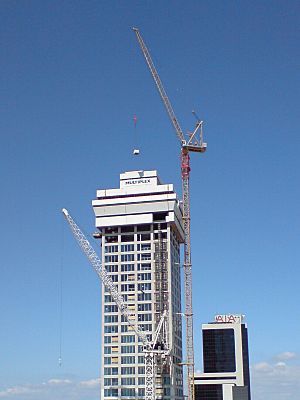
- The Takapuna Beach area is a popular spot for nightlife, with many bars, restaurants, cafes, and shops.
- Shore City Shopping Centre opened in Takapuna in 1974. It has many shops, including Farmers and New World Metro.
- Takapuna Library first opened in 1874. The current building was built in 1989. It has a special collection of local history, including old newspapers, photos, and stories.
Sports in Takapuna
Takapuna is home to Takapuna AFC, a football club. The Takapuna Rugby Football Club is located nearby at Onewa Domain.
Schools in Takapuna
Takapuna has several schools:
- Westlake Boys High School and Westlake Girls High School are single-sex secondary schools (Years 9-13). Westlake High School opened in 1958, and then split into separate boys' and girls' schools.
- Rosmini College is a Catholic boys' secondary school (Years 7–13).
- St Joseph's School is a coeducational Catholic primary school (Years 1–6).
- Takapuna Normal Intermediate is a coeducational intermediate school (Years 7–8). It opened in 1970.
- Takapuna School is a coeducational primary school (Years 1–6). It celebrated its 125th anniversary in 2004.
- Takapuna Grammar School is the main public secondary school for the area, located in Belmont.



